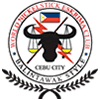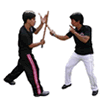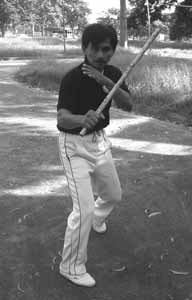


About Nickelstick
World Nickelstick Eskrima club was established on the 27th of April 2003 .The term "WORLD" is used because the Nickelstick Eskrima Club is represented by instructors from the Philippines, England, United States, and Europe. It is also our hope that we propagate Balintawak Eskrima to the rest of the World. [Learn about Balintawak] “NICKEL” is from Nick ELizar's name. “STICK” signifies the single stick style of Balintawak, while “ESKRIMA” represents the filipinized Spanish word which Filipinos have come to name their martial arts, a term that comes from the Spanish esgrima, loosely defined as "the art of fencing". We also use Balintawak style, originated from the Cebu club headed by the late Grandmaster Teofilo Velez, the late Grandmaster Atty. Jose Villasin and the late Great Grandmaster Venancio Bacon. GM Nick Elizar learned and mastered Balintawak Eskrima from the original school. It is also from this club, in which Grandmaster Nick Elizar headed the white chapter of Teovels Balintawak Group, that the World Nickelstick Eskrima Club was born. [See chapters & affiliations].
History - About GM Nick

Nicomedes “Nick” Elizar
After more than 20 years of faithfully representing Teovel’s Balintawak Group, under the White Chapter, Nick Elizar finally decided to establish his own club. In April, 2003 the World Nickel Stick Eskrima Club was established in Cebu City, Philippines. Although under a new name, the teaching methods that Nick Elizar uses are still very much the same training methods employed by Jose Villasin and Teofilo Velez. Nick Elizar has been teaching Balintawak since the 1970s. He is known as both a fighter and a good teacher. Nick Elizar has garnered respect from various eskrimadors in Cebu and throughout the Philippines. His establishment of the World Nickel Stick Eskrima Club has since been supported by many, friends and eskrimadors alike. It is the intention of Nick Elizar to continue to propagate the art of Balintawak in the Philippines and also to the rest of the World. [Learn about Balintawak]
Already well into his 50s, Nicomedes “Nick” Elizar, still looks the part of a youthful fighter in his prime with strength and tenacity embedded in his eyes. But beneath this first layer of personality lies a depth of wisdom only age can cultivate. Nick Elizar can easily be considered one of Cebu City’s best and most dedicated eskrimador. His passion for eskrima permeates into every facet of his life, radiating unto others. From his humble childhood to a violent adolescence, martial arts has taken Nick Elizar into a path of purpose, honor, and friendships. He has achieved a level of maturity in his art only possible through actual deadly encounters. The story of eskrima in Cebu, its history and the various masters who have participated in its creation, continues with the story of Nick Elizar.
Born in September 1948, in the small town of Ronda, southwest of Cebu, it was here that Nick Elizar spent the first five years of his life. At five years old, he moved to Cebu City in barangay Capitol Site, so named because of the neighborhood’s proximity to the Capitol Building. It was here that he met Guillermo “Bobby” Taboada, a contemporary and a close childhood friend. Both the boys’ parents were also very close. During those years, the area behind the Capitol was still a vast farmland and owned mostly by Mr. Vincente Gullas. This was the man that the Elizar family and the Taboada family worked for and answered directly to in matters of management and caretaking of his land. This man also owned the University of the Visayas. It was here that Nick Elizar attended school, and eventually began his life in the martial arts.
At age thirteen, while attending the University of the Visayas, Nick Elizar began to immerse himself in the sport of boxing, popularized again in the 1960s in Cebu by the international success of a local boxer named Gabriel “Flash” Elorde. While sparring with amateur boxers in the University of the Visayas, Nick Elizar also supplemented his knowledge in boxing by soliciting advice and techniques from professional boxers who trained in Ngujo boxing stable near his home. As much as he loved boxing, he always knew his parents would never approve of him devoting too much time into this endevour. Although his first passion in the fighting arts, Nick Elizar would later venture into other forms of martial arts made popular, becoming local fads in the late 1960s. He trained in Japanese Karate and Korean Tae Kwon Do around the same time his close friends began dabbling in foreign martial arts.
After completing his studies in Cebu, Nick Elizar moved to and spent one year in Manila working for the San Miguel Corporation. It was during this time that he became acquainted with Al Hipolito of the Manila Tae Kwon Do/Karate Club, where he furthered his training. After one year, he returned to Cebu in which he developed his own fighting style, combining his knowledge in boxing, karate, and tae kwon do. It was also during this time that challenges were offered to him, in which he gladly accepted. Having out done all his opponents in these matches, Nick Elizar assumed a reputation as a respectable fighter in Cebu. Known for his abilities, he was hired by a prominent local businessman as his personal bodyguard, until the onset of President Marcos’ Martial Law in 1972.
In 1972, while walking through the streets of Colon, Nick Elizar accidentally bumped into Bobby Taboada. The two childhood friends exchanged stories and updated each other about their lives. At which point, Bobby Taboada invited Nick Elizar to one of his regular training sessions in barangay Pari-an, at the corner of Sikatuna and Isagani streets. It was here that Nick Elizar re-learned everything he knew about fighting. He was introduced to Balintawak.
The Balintawak International Self Defense Club, in 1972, was headed by Jose Villasin as president, Teofilo Velez as vice-president, and Venancio “Anciong” Bacon as the organization’s honored grandmaster. Teofilo Velez was a very friendly man, who always went out of his way to make his students comfortable. But, he was the exact opposite during training. He was strict and very calculating when imparting the minutest of details of Balintawak. Jose Villasin, who was to become a godfather of Nick Elizar’s first son, was also a very “jolly” man, who was very stern when it came to training. When Nick Elizar finally met Venancio Bacon, his first impression of him was that of a quiet, humble man who was very involved in the teaching of his art. He consistently checked on Teofilo Velez and Jose Villasin’s students, making sure Balintawak and the concept of Cuentada was correctly passed on to the next generation of fighters and teachers.
Nick Elizar completed his training in 1976. He was given authority to teach Balintawak, using the training method developed by Jose Villasin. Also, during this year, Nick Elizar began working for the Bisayan Shipping Line. He was assigned to Samboan, in the southern most part of Cebu. During his off hours after work which was usually around 2 pm, instead of returning to Cebu City, Nick Elizar went to Dumaguete City which was about an hour boat ride from Samboan.
It was in Dumaguete that Nick Elizar met Ricardo Abellana, who had trained with Jose Villasin in Cebu City. Ricardo Abellana was stationed in Dumaguete. He was a Philippine Constabulary police, who also ran a local eskrima club teaching Balintawak. After meeting Nick Elizar, Mr. Abellana realized that his new found friend possessed more advance skills. Ricardo Abellana, humbly appointed Nick Elizar as the Chief Instructor of his school. During days of training, Mr. Abellana continued to teach his students, while Nick Elizar supervised and offered corrections along the way. After the students left, Nick Elizar trained Mr. Abellana in the advance stages of Balintawak. So, during Mondays, Wednesdays, Fridays, and the weekend, Nick Elizar trained students in Dumaguete. He would sleep in Ricardo Abellana’s home, waking up at 3 am the next day to report for work in Samboan. On Tuesdays and Thursdays, Nick Elizar trained his own students in Samboan. As expected, during this time “friendly” challenge matches were offered. The were all accepted by Nick Elizar.
In 1979, Nick Elizar left Samboan and returned to Cebu City, to live in Englis in Guadalupe. He resumed his training with Teofilo Velez. At this time, Nick Elizar also organized his own group of students in Englis and called it CEAC, or Central Englis Arnis Club. At this time Bobby Taboada also organized his own club in Banawa, which was adjacent to Englis. He called it Cebu Banawa Arnis Club, or CBAC. Both often trained together. Nick Elizar drove taxis for a living.
A couple of years later, an incident occurred that changed Mr. Elizar’s opinion about taxi driving. He was held up by two men. Sensing immediate danger as soon as he turned into a dark street, Nick Elizar was already on guard. The first man pulled a knife. Before he could direct his knife to Nick Elizar’s neck, it was already countered. While Nick Elizar was twisting the first man’s arm, the second who had undoubtedly realized that he and his friend picked the wrong taxi this evening, proceeded to abandon his partner. Left with only one assailant, Nick Elizar pulled his attacker out of the car, after already throwing away the knife to prevent any serious injuries. He called for help. Seeing that there was no one around, he took out his stick and proceeded to hit the would be robber. After which, he called for the police to collect the criminal. He then retired from taxi driving, looking for a better way to earn a living.
In 1982, Teofilo Velez rounded up all of his loyal students to establish his own club. In a formal ceremony held in Lapu Lapu City, Cebu, Teofilo Velez inducted 12 of his most advance instructors to the title of “Master”. Ten of these Masters were assigned their individual color chapters. Nick Elizar was assigned the White Chapter. During the ceremony the 12 Masters conferred to award their long time teacher, Teofilo Velez, the title of “Grand Master”. The new club was called the TeoVel Balintawak Group. Teofilo Velez urged each of his instructors to propagate Balintawak to all, and share everything they knew, never holding back from any student interested to learn.
Under the new TeoVel Balintawak Group, Nick Elizar organized his White Chapter, and continued to propagate Balintawak. His club chapter was one of the busiest. Mr. Elizar had always been a good teacher, quick to correct his students, while always encouraging them to stay the course.
In 1985, Nick Elizar worked as a bodyguard for Pastor “Jun” Alcober Jr., an ex-NPA officer who defected from the Communists to work for the Philippine government. Along with Narciso “Boy” Tablati, Mr. Elizar assumed his job as Mr. Alcober’s bodyguard for three years. After working for Mr. Alcober in 1988, Nick Elizar was employed by the City government of Cebu as a member of the Civil Security Unit. A few years after, Mr. Elizar was promoted to work under the Office of the Mayor’s Monitoring Group. He faithfully serves this position until now.
Since the death of Teofilo Velez in 1989, Nick Elizar has kept his promise to diligently propagate the art began by Venancio Bacon. Mr. Elizar was awarded the title “Chief Instructor” of TeoVel’s Balintawak in 1994. In 1998 and 2000, Nick Elizar represented the TeoVel’s Balintawak Group in the WEKAF conferences held in Cebu. He has instructed Filipinos and non-Filipinos alike, always keeping in mind Teofilo Velez’s philosophy of sharing everything you know about the art to the next generation of eskrimadors.
In 2003, Nick Elizar organized his new club and christened it NickEl Stick Balintawak. What was before the TeoVel’s Balintawak White Chapter is now NickEl Stick Balintawak with two supporting chapters in Englis, headed by his brother Bobby Elizar, and in Don Pedro Cui, headed by Ruben Rana. Both Bobby Elizar and Ruben Rana were also instructors under Teofilo Velez. Since the establishment of NickEl Stick, the club has performed Balintawak demonstrations throughout Cebu City. Early every Sunday morning the entire club meets for training in Ayala Park, which gives Nick Elizar the chance to check on the students who are under his two other chapters. It has been over 30 years since Nick Elizar started training in Balintawak. He has since met many great eskrimadors and students. He encountered violence many times and survived. Balintawak has taken him where he is now. But, more importantly Nick Elizar will always remember the friendships he has forged through Balintawak. Nick Elizar can easily claim to be one of Cebu’s premier eskrimadors.